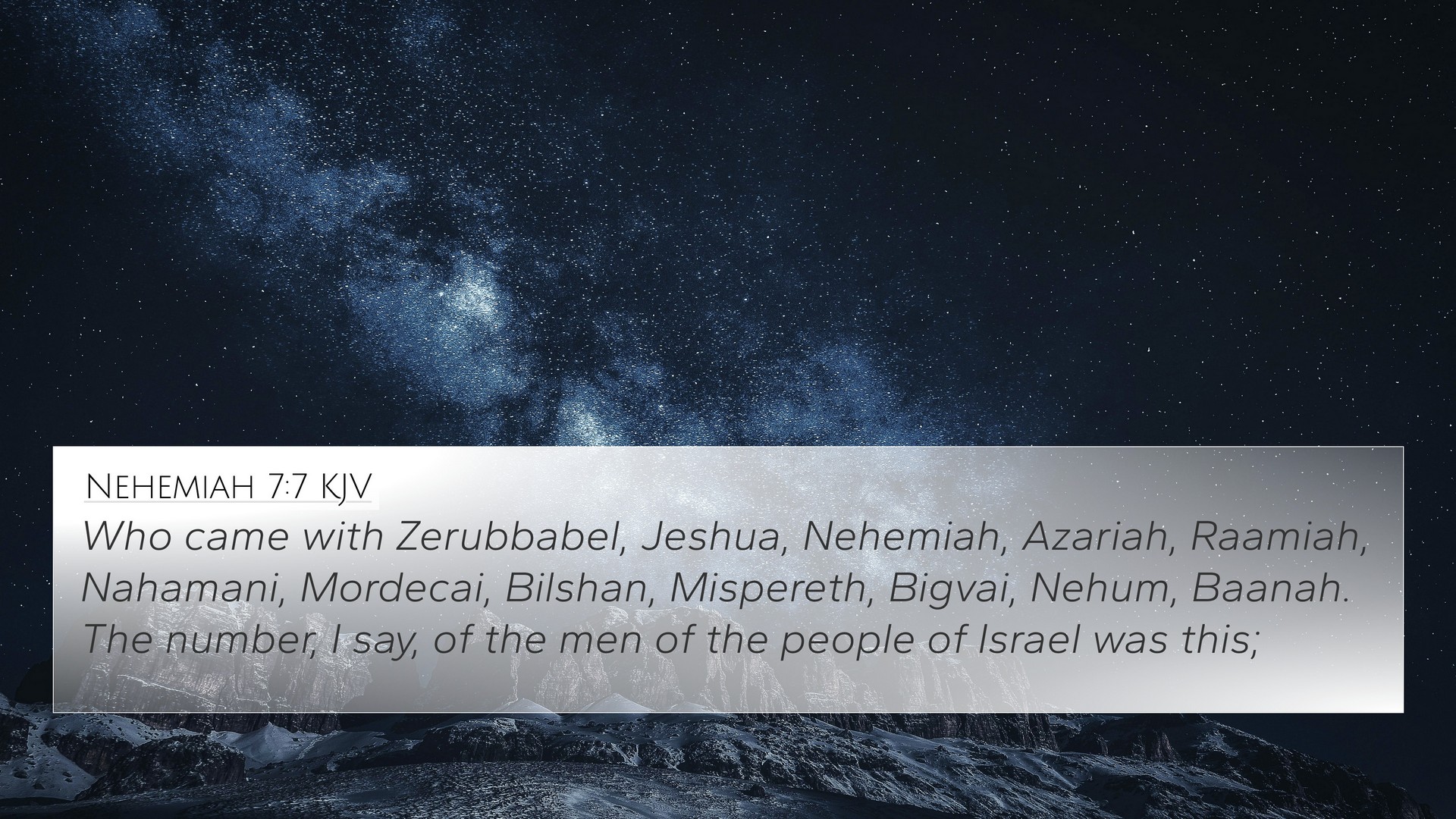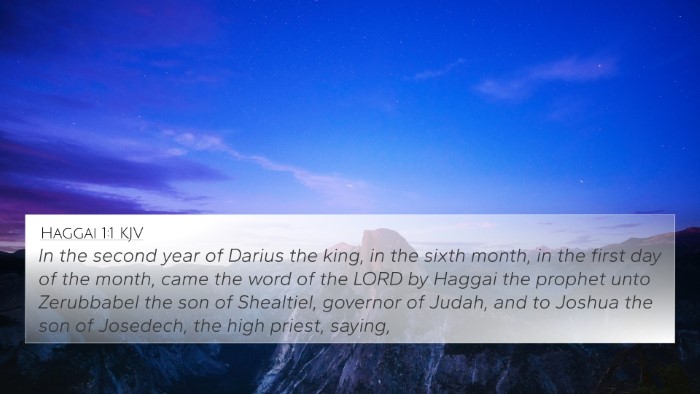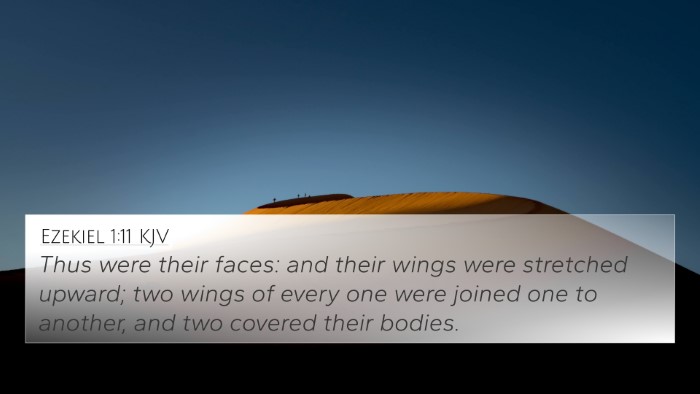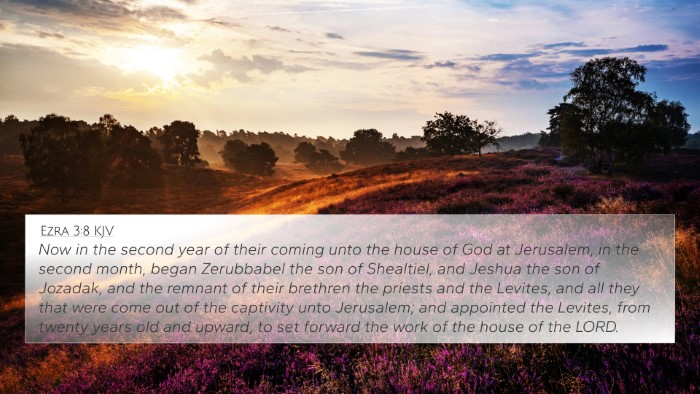Nehemiah 7:7 - Understanding the Context and Meaning
Bible Verse: Nehemiah 7:7
Nehemiah 7:7 reads, “They came with Zerubbabel, Jeshua, Nehemiah, Azariah, Rahemiah, Nahamani, Mordecai, Bilshan, Mispereth, Bigvai, Nehum, and Baanah. The number of the men of the people of Israel:
This verse is part of the broader narrative in the Book of Nehemiah, which details the return of the exiles from Babylon to Jerusalem. It provides a record of those who returned to help rebuild Jerusalem and restore its people.
Significance of the Verse
The names listed, including notable figures such as Zerubbabel and Nehemiah, highlight the leadership involved in this significant historical moment. Each name represents a segment of the community that played a role in the restoration and re-establishment of Israel.
Insights from Commentators
-
Matthew Henry:
Henry emphasizes the importance of recognizing names in Scripture, which often connect to significant events and figures in the history of God’s people. He notes that these individuals are not merely names, but represent the faithfulness of the remnant who returned to rebuild after captivity.
-
Albert Barnes:
Barnes focuses on the collective effort represented in the returning exiles. Each name contributes to the larger narrative of restoration, demonstrating how God’s plan unfolds through individual contributions and community effort. He highlights the significance of their return as a fulfillment of God's promises.
-
Adam Clarke:
Clarke draws attention to the leadership roles mentioned in the verse. He identifies how these leaders not only physically returned to Jerusalem but also spiritually led the people in revitalizing their faith and commitment to God’s covenant.
Bible Verse Cross-References
To fully understand Nehemiah 7:7, it is beneficial to explore its connections with other scriptures:
- Ezra 2:1-2: This passage lists the returnees from Babylon, paralleling the names found in Nehemiah.
- Nehemiah 1:3: Nehemiah hears about the distress of those who remained in Jerusalem, motivating his actions.
- Jeremiah 29:10: Indicates God’s plan to restore His people after the exile.
- Zechariah 8:4-5: Prophecies of restoration that coincide with Nehemiah's efforts.
- Haggai 1:14: Highlights God stirring the hearts of the people to work on the house of the Lord.
- Isaiah 44:28: Discusses the role of Cyrus in facilitating the return, linking to the restoration theme.
- Hebrews 11:32-34: References faith shown by leaders in the Old Testament, resonating with the faithfulness of Nehemiah and Zerubbabel.
Thematic Bible Verse Connections
Nehemiah 7:7 serves as a bridge between the themes of leadership, community, and restoration throughout Scripture. The collective effort illustrated in this verse enhances our understanding of God's overarching plan of redemption:
- Restoration of God's People: Similar to the theme found in various prophetic books that stress God's desire to restore Israel.
- Importance of Leadership: Engaging with verses like 1 Timothy 5:17, which elevates the role of godly leaders in the church.
- Community and Cooperation: Echoed in Acts 2:44-47, where believers worked together for the common good.
Tools for Bible Cross-Referencing
For those studying Nehemiah 7:7 and looking for deeper insights, several tools and methods can enhance the process of cross-referencing:
- Bible Concordance: A useful resource for locating passages related to specific keywords or themes.
- Bible Cross-Reference Guide: Helps to navigate connections between verses effectively.
- Cross-Reference Bible Study: A method of exploring related themes and verses for a more comprehensive understanding.
Inter-Biblical Dialogue
The narrative in Nehemiah opens dialogue between the Old Testament events and their implications in the New Testament. For instance, the restoration of Jerusalem points toward the New Testament idea of the Church as a restored community of believers, emphasizing continuity in God’s salvific plan.
Conclusion
Nehemiah 7:7 encapsulates a pivotal moment in Biblical history, illustrating the commitment of a faithful remnant to God’s purpose. By exploring its connections through cross-referencing, we can appreciate the richness of Scripture as it weaves together the stories of redemption and restoration, inviting further exploration and study.
For further study, consider utilizing comprehensive Bible reference resources that facilitate a deeper understanding of how Nehemiah 7:7 interacts with other biblical texts and encourages a unified view of the Bible’s message.














